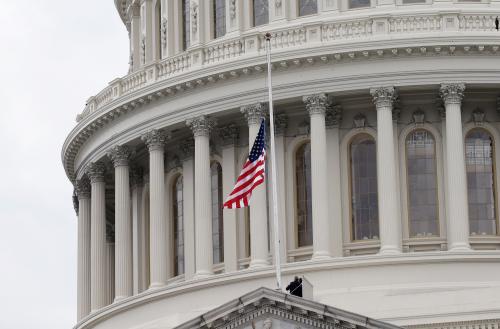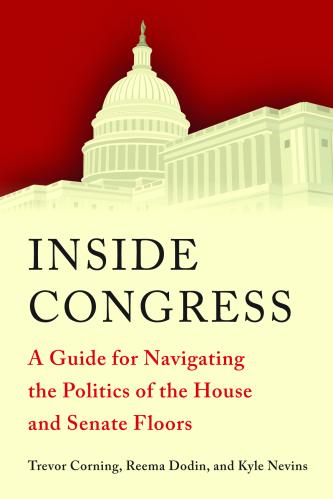President Donald Trump may be traveling abroad, but his administration’s first budget request was released this morning. Here are four major takeaways:
Yes, the Trump budget contains dramatic cuts to many federal programs…
The Trump administration’s first full budget request contains significant cuts to many federal programs, especially those that aid vulnerable Americans, including Medicaid, the Supplemental Nutrition Assistance Program (SNAP), and Social Security Disability Insurance, and agencies the Trump administration has criticized, like the Environmental Protection Agency. These large reductions are accompanied by small increases in a few areas, such as defense spending and border security. On the revenue side, the document relies on extremely optimistic assumptions; it also omits the costs of Trump’s proposed tax plan while still claiming its benefits
…But Congress holds the power of the purse.
The president’s budget request is just that: a request. Certainly, it serves as a key statement of administration priorities, though, in this case, we should probably think of the “administration” less as President Trump and more as Office of Management and Budget Director Mick Mulvaney. It can also function as an important basis from which congressional decision-makers work as they develop spending legislation. At the end of the day, however, Congress makes decisions about what to put in the bills it sends to the president for his signature. Democrats, unsurprisingly, have roundly rejected Trump’s proposal, but even the president’s co-partisans have also suggested that certain components may be non-starters for them. Among the Republicans questioning some proposals are members of the House Appropriations Committee, including Rep. Tom Cole (R-Okla.) and Rep. Mike Simpson (R-Idaho). Political science research has shown that disagreement between majority appropriators and the rest of the majority party in the chamber can slow down appropriations work; these differences may affect the shape of the process going forward.
What if Congress likes the president’s proposals?
The federal budget involves two kinds of spending: discretionary and mandatory. The former is handled through the annual appropriations process. In principle, this involves the drafting of 12 separate spending bills for different policy areas (defense, agriculture, energy and water development, etc.) by individual Appropriations subcommittees in the House and Senate. After review by each chamber’s full Appropriations committee, the measures are considered on the floors of both houses. The House and Senate must then agree on a compromise version of each before sending it to the president for his signature. In practice, however, Congress has frequently struggled with completing these steps and instead has often combined the separate bills into one, large omnibus package.
Regardless of which approach Congress takes, however, discretionary appropriations bills must clear the threat of a filibuster in the Senate. Absent a change to Senate precedents for considering spending bills, then, they must attract the support of at least eight Senate Democrats before they are sent to the president. Not only are Democrats likely to object to specific programmatic cuts, but a two-year budget deal relaxing the discretionary spending caps put in place in 2011 expires this year. As a result, Congress is likely headed for another fight over whether to ease those limits, and if so, whether to treat the defense and non-defense sides of the budget similarly. Democrats went to bat for equal treatment in 2015. It will be important to watch whether they do so again, as well as how Republicans respond.
Changes on the mandatory side of the budget, on the other hand, can be made through the budget reconciliation process; these would include potential cuts in programs like Medicaid, SNAP, Temporary Assistance for Needy Families (TANF), and the Children’s Health Insurance Program (CHIP). The procedures for considering reconciliation bills limit debate on them in the Senate, preventing a potential filibuster. While much attention has been paid to the fact that Republicans would like to use the reconciliation process for tax legislation later this year, some in the party have also proposed using it for broader changes to mandatory spending programs. (Others have questioned such a move.) If the party chooses to pursue that route, and if it can reach agreement on what such a proposal would look like—both huge ifs—it is possible that some cuts could be enacted without Democratic support in the Senate.
Even the “easy” parts may not be so easy.
As the debate over Republicans’ health care legislation this spring has demonstrated, even when the party chooses to use the expedited reconciliation process, it can be difficult to build a coalition in support of potentially unpopular cuts in government services. In addition, to initiate the reconciliation process for fiscal year 2018, the House and Senate must first agree on a budget resolution containing reconciliation instructions, or directions to particular committees to write language that changes the mandatory spending programs (and/or revenue provisions) in their jurisdictions. While the budget resolution can be adopted without Democratic support, Republicans’ intraparty disagreements may also make that task difficult. Different factions within the party prioritize different goals for the budget resolution, including increasing defense spending, cutting taxes, and balancing the federal budget in ten years. A party-line strategy certainly has its benefits, but if Republicans falter, all attention will be on the party’s inability to deliver, rather than on Democrats’ unwillingness to compromise.
Will Republicans be able to overcome these internal divisions? It’s certainly possible, but they will have to do so in the shadow of an unpopular president and concerns, at least in the House, about possible seat losses in next year’s midterm elections. In addition, a September showdown over the discretionary side of the budget, the debt limit, and several other must-pass measures has the potential to shape the politics of this year’s budget season. But today’s proposal from the Trump administration is just the first step in a long process.










Commentary
Trump’s budget request puts Congress on a rocky path
May 23, 2017